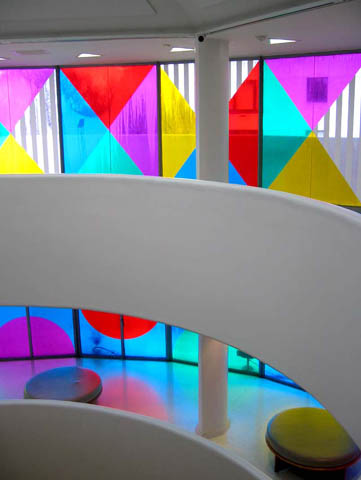
Public Art and Sports Teams: Is Denver Trapped in the Safety Zone?
Im not a big fan of Jerry Jones, the hovering owner of the Dallas Cowboys who thinks hes as qualified to be on the field coaching as his coaches. But I found a recent quote by him somewhat insightful.
“Football is full of the unexpected and the spontaneous-it can make two strangers into friends. Art has the power to do that too, to get people talking, and looking, and interacting.”
Its not improbable that a football fan would also be an art lover. I mean hey, Rocco Landesman is a huge baseball fan and star Broadway producer (now hes the head of the NEA). I think Jones has an interest in art. Ive talked with a master metal artist who created custom designed doors and ornamentation for Jerrys home, so it shouldnt be surprising that the Dallas Cowboys launched an art program as an amenity to their new $1.15 billion stadium. Curators Michael Auping of the Modern Art Museum of Fort Worth and Charles Wylie of the Dallas Museum of Art, and collectors Howard Rachofsky and Gayle Stoffel, helped make the program possible. San Francisco art advisor Mary Zlot helped select the work of mostly male artists–Franz Ackermann (below), Mel Bochner, Daniel Buren, Olafur Eliasson, Dave Muller, Matthew Ritchie and Lawrence Weiner–which is installed on the entry ramps, staircases, pedestrian ramps and in the main concession areas of the stadium.

Franz Ackermann, Installation view TERMINAL Meyer Riegger, Karlsruhe, Germany © Meyer Riegger
One would think that Denver (a city as in love with its arts and culture as it is its sports) would have been the first to embrace a model for merging art and football.

Daniel Buren, "Eye of the Storm," installation view at the Guggenheim Museum
Every year, Denver arts and cultural organizations proudly announce that their attendance is greater than the attendance at all professional sporting events. In other words, more people go to museums, the zoo, the botanic gardens and attend performing arts productions than attend Broncos football games, Rockies baseball games, Denver Nuggets basketball games, Avalanche hockey games, Mammoth lacrosse games, Rapids soccer games, Crush arena football games, and Denver Dynamite arena soccer games. The statistic seems to hold up. Of course, it makes sense when you realize this includes everything from the Alliance Francaise to Wings over the Rockies Air & Space museum.
Denver supports its arts and culture through the Scientific & Cultural Facilities District. Residents in the seven-county Denver metro area have voted three times to approve a 1/10 of a cent sales tax increase for the arts. In 2007, more than $42 million was collected and distributed to 300 arts and cultural organizations. Thats the same tax rate approved by voters in 1998 to build the new Invesco Field at Mile High. The stadium cost $364.2 million, a whole lot less than the Cowboys new home. Compare that to the $67 million cost for the new Hamilton building of the Denver Art Museum.
For all its love of the arts, culture and sports, Denver still hasnt figured out how to be progressive and forward thinking. The culture of Denver is very Western, very tied to the landscape, very much about the wildlife. Consider the public art installed at Invesco Field (compared to what will fill the Cowboys stadium): A bronze sculpture of 5 broncs, 1 mare and 1 colt running up a hill, crafted by Italian artist Sergio Benvenuti. An oversized “Equipment Field” of cleats, mouth guard and helmet shield crafted from Colorado marble and strewn across an entrance to the stadium. A “Mountainscape” made of large rocks in the shape of a labyrinth and metal aspen trees and “Pigskin Variations” featuring a cowboy riding a football, rock climbers climbing a football and Sisyphus pushing a football up a hill. Even the iconic fiberglass “Bucky” that sat atop the old stadium was moved to the new stadium. He was cast from a mold made of Trigger, Roy Rogers horse. The only catch? Denver couldnt name the horse “Trigger” so they called him “Bucky” the Bronco.
The work is pleasant, appealing, safe. In fact, most of the public art in Denver is safe and relatively non controversial. The most talked about art in Denver is Herbert Bayers “Articulated Wall” and Luis Jimenezs “Blue Mustang.” The controversy over “Blue Mustang” I suspect was unexpected, I mean, its a horse. How controversial can that be?
Now take a look at what may happen to the Land Shark Stadium in Miami.
Miami Dolphins owner Stephen M. Ross announced on Aug. 7 that the stadium would be getting a makeover courtesy of Miami-based Neo-Pop artist Romero Britto. The artist is being brought in to decorate the entrances to the stadium with his “iconic helixes,” and the project is expected to be unveiled in time for the season opener September 21 against the Indianapolis Colts.
Ross described his fine art initiative as part of a “grand plan for making the Dolphins the most talked about franchise in professional sports.”
And for all the right reasons, not because you fired your coach (Mike Shanahan), lost your crybaby quarterback (Cutler) and have a disgruntled wide receiver (Brandon Marshall) whos made more appearances in court than at training camp.
The biggest risk the Mile High City has taken was in selecting Daniel Libeskind to design the Hamilton Building, which has been overwhelmingly panned by architectural critics around the world as a nice piece of poetry, but a lousy work of architecture.
Personally, I love the building, angles and all. At least it gets people talking. Which is more than can be said about the public art at Invesco Field. But I guarantee that people in Dallas will be talking when they see what is installed at their football stadium.
